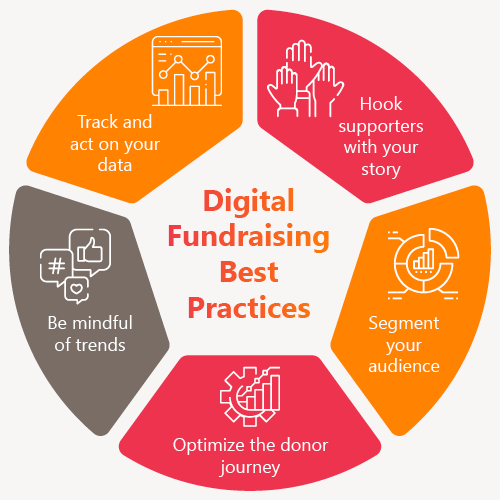Online Fundraising: Proven Tactics to Elevate More Funds for Your Nonprofit
Online Fundraising: Proven Tactics to Elevate More Funds for Your Nonprofit
Blog Article
The Duty of Community Engagement in Nonprofit Fundraising: Structure Lasting Relationships for Lasting Assistance
Neighborhood involvement is progressively acknowledged as a vital element of effective not-for-profit fundraising. The approaches and approaches used to engage neighborhoods vary commonly, raising essential inquiries about efficiency and influence.
Comprehending Neighborhood Engagement
Neighborhood engagement is an important component of successful not-for-profit fundraising efforts. It refers to the strategies and activities that companies use to connect with their neighborhood neighborhoods, fostering partnerships that are equally beneficial. Recognizing community engagement involves recognizing its complex nature, that includes collaboration, participation, and outreach. Nonprofits should identify key stakeholders-- such as community participants, neighborhood companies, and other organizations-- to create effective engagement methods.
Reliable area interaction is predicated on energetic listening and responsiveness to the demands and rate of interests of the community. This process includes obtaining comments, recognizing neighborhood characteristics, and making sure that the company's objective aligns with local top priorities. Engaging the area can take different types, including public conferences, volunteer chances, and partnership initiatives, each created to urge involvement and financial investment in the company's objectives.
Furthermore, area involvement should be come close to as a recurring discussion as opposed to an one-time initiative. By cultivating an inclusive atmosphere where community voices are listened to and valued, nonprofits can construct a strong foundation for future fundraising ventures. Eventually, a deep understanding of community involvement encourages organizations to create genuine links that boost their overall efficiency and sustainability.
Benefits of Strong Relationships
Solid relationships formed with area engagement return numerous advantages for not-for-profit fundraising initiatives. Primarily, these relationships foster trust fund and trustworthiness, important elements in encouraging benefactors to add. When prospective fans see a nonprofit proactively associated with their area, they are more probable to count on its objective and influence.

In addition, these relationships help with reliable interaction. Nonprofits can take advantage of their connections to share stories of influence, updates, and requires, ensuring that advocates continue to be informed and involved. This open line of communication not only strengthens bonds yet also encourages word-of-mouth promo, increasing the not-for-profit's reach.
Finally, solid neighborhood ties can draw in new partners and enrollers. Companies and individuals are a lot more likely to align with organizations that show meaningful neighborhood involvement, providing additional resources and assistance that can substantially enhance fundraising capabilities. Hence, cultivating robust connections through area interaction is essential to a not-for-profit's long-term fundraising success.
Strategies for Reliable Engagement
Exactly how can nonprofits effectively involve their communities to improve fundraising initiatives? Routine updates, engaging content, and calls-to-action can galvanize area rate of interest and participation.
Second, holding area occasions, such as workshops, volunteer chances, or fundraising drives, assists in in person communication, enabling nonprofits to display their effect and efforts. These occasions not only raise funds yet also grow connections and enable community participants to involve straight with the cause.
Third, carrying out individualized interaction approaches can enhance involvement. Customizing messages to particular benefactor sections based upon rate of interests and past payments cultivates a feeling of belonging and financial investment in the company's mission.
Lastly, developing partnerships with neighborhood organizations and community leaders can amplify outreach initiatives. Joint campaigns can improve exposure and trustworthiness, demonstrating a cumulative dedication to the neighborhood's wellness. By integrating these approaches, nonprofits can develop lasting partnerships that improve fundraising efforts and drive sustainable assistance.
Gauging Interaction Success
While involving the area is vital for successful not-for-profit fundraising, gauging the effectiveness of these engagement efforts is just as essential. Developing clear metrics allows companies to analyze how well they are connecting with their audience and attaining their fundraising objectives. Trick efficiency indicators (KPIs) such as donor retention prices, volunteer helpful hints participation degrees, and interaction on social media platforms offer concrete information for analysis.

Routinely evaluating these metrics makes it possible for organizations to pivot their approaches when necessary, making certain that area involvement continues to be aligned with their overall objective. In addition, sharing these outcomes with stakeholders fosters openness and constructs trust, motivating more neighborhood participation. Inevitably, a robust dimension structure not only educates future fundraising efforts yet also enhances the relationship between the nonprofit and its supporters, preparing for lasting success.
Situation Studies in Area Influence
Countless case research studies highlight the extensive effect that community interaction can have on not-for-profit fundraising success. One significant example is the "Something to chew on" campaign, where a regional food financial institution partnered with schools and companies to host community dinners. These occasions not just increased funds but also fostered a sense of belonging amongst participants, substantially raising contributor retention rates.
An additional compelling situation is the "Eco-friendly Spaces Task," which included neighborhood homeowners in the revitalization of city parks. This effort not only amassed financial backing from local organizations check over here but additionally cultivated a volunteer base that added to recurring maintenance and programming. The feeling of ownership and pride amongst community participants converted into sustained contributions.
In the realm of arts, the "Art for All" campaign successfully engaged neighborhood artists and clients to develop joint art installations, bring about increased presence and contributions for a neighborhood arts not-for-profit.
These instances highlight that when nonprofits focus on area involvement, they like this can produce long-term partnerships that improve fundraising initiatives, making sure lasting assistance and cultivating a dynamic community society. Such instances show that area engagement is not simply a strategy but an important pillar of nonprofit success.
Final Thought
In verdict, area engagement is essential to the success of nonprofit fundraising efforts. By promoting strong relationships with regional stakeholders, organizations boost trust and integrity, causing improved contributor retention and commitment. Carrying out reliable interaction techniques and determining their effect makes sure that nonprofits can prosper and adapt. Inevitably, a robust structure of neighborhood assistance not only amplifies fundraising potential yet additionally grows a culture of cooperation, important for accomplishing long-lasting organizational goals and maintaining meaningful influence.
Nonprofits must recognize essential stakeholders-- such as community members, local services, and other companies-- to develop effective involvement methods.

In verdict, community interaction is integral to the success of not-for-profit fundraising initiatives.
Report this page